Isoproterenol and cAMP block ERK phosphorylation and enhance [Ca2+]i increases and oxygen consumption by muscarinic receptor stimulation in rat parotid and submandibular acinar cells
- PMID: 20207737
- PMCID: PMC2859492
- DOI: 10.1074/jbc.M110.112094
Isoproterenol and cAMP block ERK phosphorylation and enhance [Ca2+]i increases and oxygen consumption by muscarinic receptor stimulation in rat parotid and submandibular acinar cells
Abstract
Salivary glands are innervated by sympathetic and parasympathetic neurons, which release neurotransmitters that promote fluid secretion and exocytosis when they bind to muscarinic and beta-adrenergic receptors, respectively. Signaling pathways downstream of these receptors are mainly distinct, but there is cross-talk that affects receptor-dependent events. Here we report that the beta-adrenergic ligand isoproterenol blocks increases in extracellular signal-related kinase (ERK) phosphorylation, a protein kinase C-dependent event promoted by the muscarinic receptor ligand carbachol in freshly dispersed rat parotid acinar cells. The inhibitory action of isoproterenol was reproduced by cAMP stimuli (forskolin) and mimetics (dibutyryl-cAMP, 8-(4-chlorophenylthio)-cAMP), including one highly selective for protein kinase A (N(6)-benzoyl-cAMP). In contrast, Epac (exchange proteins directly activated by cAMP)-selective activators did not mimic the blockade of ERK by isoproterenol, suggesting that inhibition involved protein kinase A. Isoproterenol also blocked ERK downstream of phorbol 12-myristate 13-acetate and the P2X(7) and epidermal growth factor receptors. Isoproterenol and forskolin blocked MEK phosphorylation, reduced RAF phosphorylation on a stimulatory site (Ser-338), and increased RAF phosphorylation on an inhibitory site (Ser-259). Inhibitory effects on ERK were also observed in freshly dispersed rat submandibular acinar cells but not in three immortalized/cancer salivary cell lines (Par-C10, HSY, HSG), indicating significant differences between native cells and cell lines. Notably, in native parotid cells isoproterenol enhanced the carbachol-promoted increases in [Ca(2+)](i) and oxygen consumption, events that initiate and accompany, respectively, the stimulation of fluid secretion by muscarinic ligands. Thus, isoproterenol produces opposite effects on prominent events downstream of the muscarinic receptor second messengers diacylglycerol (decrease in ERK phosphorylation) and inositol trisphosphate (increase in [Ca(2+)](i) and fluid secretion).
Figures
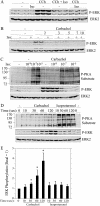

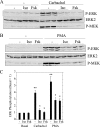

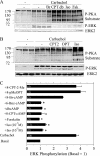



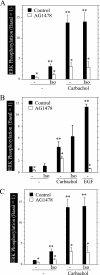
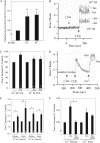
Similar articles
-
cAMP potentiates ATP-evoked calcium signaling in human parotid acinar cells.J Biol Chem. 2004 Sep 17;279(38):39485-94. doi: 10.1074/jbc.M406201200. Epub 2004 Jul 19. J Biol Chem. 2004. PMID: 15262999
-
Beta-adrenergic receptor stimulation induces inositol trisphosphate production and Ca2+ mobilization in rat parotid acinar cells.J Biol Chem. 1988 Sep 5;263(25):12454-60. J Biol Chem. 1988. PMID: 2900837
-
Phosphorylation of inositol 1,4,5-trisphosphate receptors in parotid acinar cells. A mechanism for the synergistic effects of cAMP on Ca2+ signaling.J Biol Chem. 2002 Jan 11;277(2):1340-8. doi: 10.1074/jbc.M106609200. Epub 2001 Nov 1. J Biol Chem. 2002. PMID: 11694504
-
Regulation of phospholamban and troponin-I phosphorylation in the intact rat cardiomyocytes by adrenergic and cholinergic stimuli: roles of cyclic nucleotides, calcium, protein kinases and phosphatases and depolarization.Mol Cell Biochem. 1995 Aug-Sep;149-150:103-26. doi: 10.1007/BF01076569. Mol Cell Biochem. 1995. PMID: 8569720 Review.
-
Exchange protein directly activated by cAMP (epac): a multidomain cAMP mediator in the regulation of diverse biological functions.Pharmacol Rev. 2013 Feb 27;65(2):670-709. doi: 10.1124/pr.110.003707. Print 2013 Apr. Pharmacol Rev. 2013. PMID: 23447132 Review.
Cited by
-
Parasympathetic stimulation improves epithelial organ regeneration.Nat Commun. 2013;4:1494. doi: 10.1038/ncomms2493. Nat Commun. 2013. PMID: 23422662 Free PMC article.
-
Epac1 deacetylates HMGB1 through increased IGFBP-3 and SIRT1 levels in the retinal vasculature.Mol Vis. 2018 Nov 16;24:727-732. eCollection 2018. Mol Vis. 2018. PMID: 30581279 Free PMC article.
-
Muscarinic type 3 receptor induces cytoprotective signaling in salivary gland cells through epidermal growth factor receptor transactivation.Mol Pharmacol. 2012 Jul;82(1):115-24. doi: 10.1124/mol.111.077354. Epub 2012 Apr 17. Mol Pharmacol. 2012. PMID: 22511543 Free PMC article.
-
Regulation and identification of Na,K-ATPase alpha1 subunit phosphorylation in rat parotid acinar cells.J Biol Chem. 2010 Nov 19;285(47):36330-8. doi: 10.1074/jbc.M110.136465. Epub 2010 Sep 14. J Biol Chem. 2010. PMID: 20841356 Free PMC article.
-
Ciliary subcellular localization of TGR5 determines the cholangiocyte functional response to bile acid signaling.Am J Physiol Gastrointest Liver Physiol. 2013 Jun 1;304(11):G1013-24. doi: 10.1152/ajpgi.00383.2012. Epub 2013 Apr 11. Am J Physiol Gastrointest Liver Physiol. 2013. PMID: 23578785 Free PMC article.
References
-
- Proctor G. B., Carpenter G. H. (2007) Auton. Neurosci. 133, 3–18 - PubMed
-
- Dai Y. S., Ambudkar I. S., Horn V. J., Yeh C. K., Kousvelari E. E., Wall S. J., Li M., Yasuda R. P., Wolfe B. B., Baum B. J. (1991) Am. J. Physiol. 261, C1063–C1073 - PubMed
-
- Melvin J. E., Yule D., Shuttleworth T., Begenisich T. (2005) Annu. Rev. Physiol. 67, 445–469 - PubMed
Publication types
MeSH terms
Substances
Grants and funding
LinkOut - more resources
Full Text Sources
Research Materials
Miscellaneous

